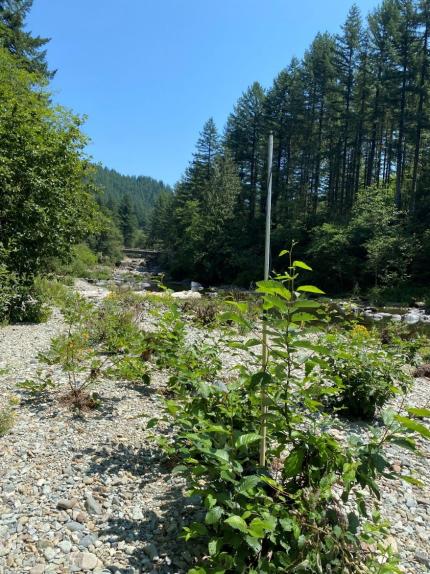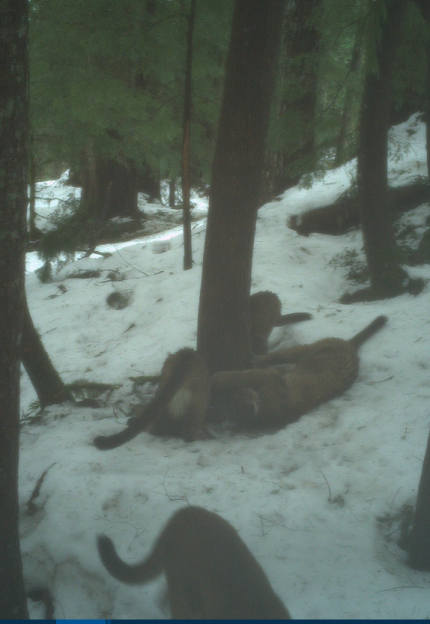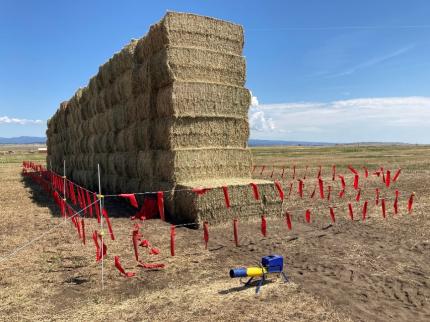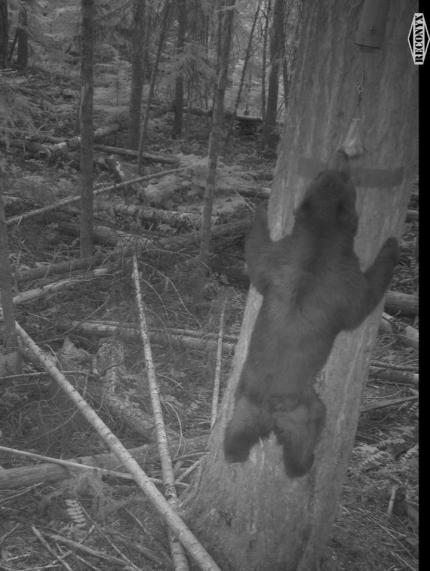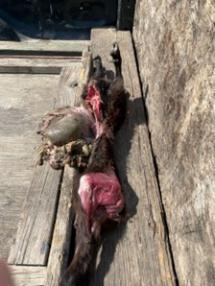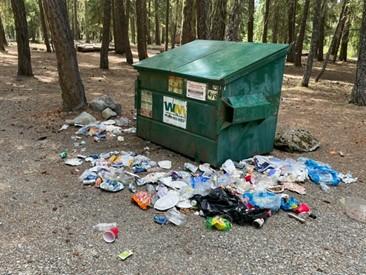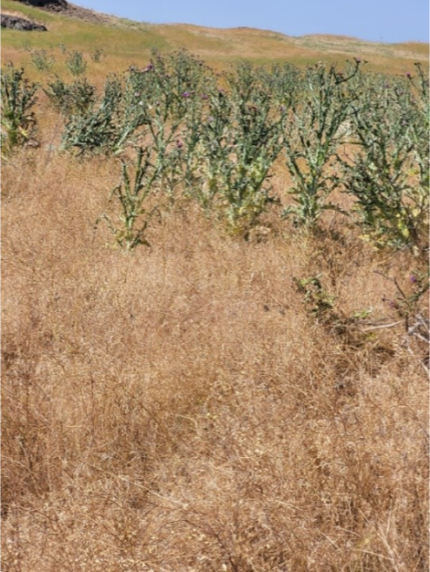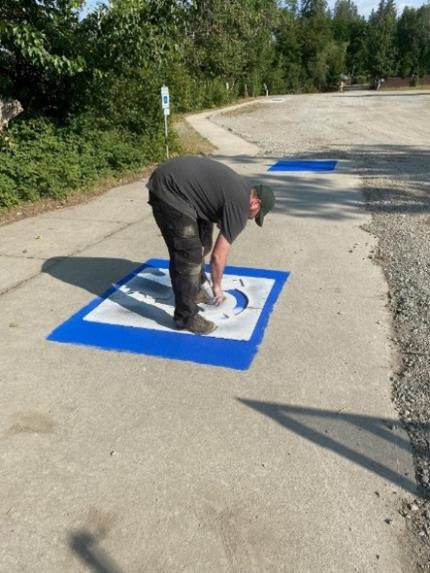Biweekly report Jul1-15 2024 - Region 6 (Coastal)
Managing Wildlife Populations
Rat Island Terns: Wildlife Veterinarian Haman and Wildlife Area Manager Laushman visited Rat Island, part of the North Olympic Wildlife Area’s Marrowstone Unit, to check on the nesting population of Caspian terns.
Wolf Monitoring: Biologist Tirhi and Volunteer Terry spent a half day getting a remote camera deployed at higher elevation off Highway 410 on U.S. Forest Service land bordering Mt. Rainier to the change battery and SD card. Between District 11 and partners at Northwest Trek, 12 cameras are currently deployed around the Carbon and White river drainages for monitoring wolf recolonization in the district. No wolves have been detected on cameras to date since the monitoring began in July 2019 when the first credible report of a suspected wolf was reported near Wilkenson.
Snake Fungal Disease (SFD): At the request of Washington Department of Fish and Wildlife’s (WDFW) Dr. Haman, District 11 staff members are piloting a garter snake collection program to test for SFD following emerging reports of this debilitating snake disease. There were two reports and one confirmation of the fungus that causes SFD at the Billy Frank Jr Wildlife Refuge near Lacey. District 11 has deployed cover boards at South Puget Sound Wildlife Area for snake use and collection. Collection will be attempted at other sections of this wildlife area as well as on Joint Base Lewis McChord (JBLM) and potentially, at other sites in the district. Snakes that are captured are swabbed and any lesions are measured and photographed. Severely infected snakes will be sent to a rehabilitator while dead snakes will be sent to the lab for testing. SFD only affects snakes.
Bats Emergence Surveys: Biologist Tirhi organized the District 11 annual bat emergence surveys. Of the six bat colonies targeted for long term monitoring of White Nose Syndrome (WNS) in District 11, surveys were conducted at the Elbe colony and Western State Hospital (Steilacoom) colony. The survey showed colony counts were significantly down at both, more with the Western State Hospital colony likely due to impacts other than WNS. Elbe count dropped from 147 bats in 2023 to 56 bats in 2024, the lowest count at the colony in the years of monitoring. There is no known change or disturbance at this colony to explain this significant drop. Tirhi will be visiting neighboring homes to ask if anyone has had an influx of bats this season.
Western State Hospital count dropped from 206 bats in 2023 to 49 bats in 2024. The hospital underwent major demolition this year leading up to the bat season including the removal of the building that housed the largest number of bats roosting at the complex. This undoubtedly was responsible for the major decline in numbers. There is no way to determine where more than 150 female bats went to birth this year, but they did not use the hospital grounds. Tirhi had surveyors encircling the complex who would have counted bats had they moved to a new location.
Biologist Cent also conducted District 17 pre-emergence exit counts at two colonies in Grays Harbor County.
Northwestern Pond Turtles: Biologist Butler, Biologist Tirhi, Technician Cheney, Volunteer Terry, and JBLM interns finished up the 2024 nest monitoring season. There were 19 breeding size adult females tracked this season at the Pierce County recovery site. A VFH transmitter was attached to each female during the spring trapping session. WDFW staff members and volunteers monitored these turtles every day via visual observations and telemetry from noon until 8 p.m. starting mid-May through mid-July.
This nesting season started off cooler and wetter than previous years, leading to a later start to nesting. The first nest was found around June 10 and the last was found on June 19. A total of eight nests were found. All but one of the nests went to the Woodland Park Zoo to enter the head-starting program, with one nest remaining in the ground at the Pierce County recovery site. There were an additional four turtles found out of the pond this season with no nest located. These turtles may have nested outside the monitoring time which caused us to miss their nests. Monitoring continued into the second week of July with the hope of increasing the number of nests found, but unfortunately there was no out of pond activity since June 19. The official monitoring season came to an end, but staff members and volunteers will sporadically monitor while conducting other work at the site through July and August.
Snowy Plovers: Biologist Cent continues to assist with plover nest searches and chick banding. Three chicks were captured and banded at Copalis Spit.
Band-Tailed Pigeon: Biologist Novack and Biologist Cent conducted the annual mineral site survey at the recently discovered Moclips site. This is the third year surveying this site, which will allow for its inclusion into the range wide survey. 34 birds were counted, which is within the typical range for this site.
District 10 Biologist Holman brought his agency boat and assisted Biologist Novack with the band-tailed pigeon survey at Cosmopolis. This survey requires boating up the Chehalis River from Aberdeen. A total of 212 birds were counted at this site.
Biologist Novack discovered a large group of more than 60 band-tails near Grayland. He contacted the landowner and made tentative arrangements to try and capture a few birds for placement of transmitters. The feeding site is over 19 miles from either of the closest known mineral sites.
Providing Recreation Opportunities
Hunting Season 2024-2025: Biologist Tirhi responded to approximately ten phone calls from hunters seeking input on permit hunts they were successfully drawn for. Tirhi provided information, maps on access, and prospects. Tirhi also randomly spoke to hunters in the field while doing other field work.
Conserving Natural Landscapes
North Olympic Equipment Repair: Assistant Regional Program Manager Blankenship helped Wildlife Area Manager Laushman repair a flat tire on a new zero turn mower at the North Olympic Wildlife Area.
Potential Acquisition Site Visits: Wildlife Area Manager Laushman and Assistant Regional Program Manager Blankenship visited with a landowner and project partners from the Jefferson Land Trust to look at areas along Chimacum Creek that could be part of a future donation for habitat conservation.
Recreational Conservation Office (RCO) Grant: Biologist Novack finalized the Lands 20/20 application for additional parcels in the Willapa Bay area and revised the RCO riparian grant proposal for lands in Chehalis Valley.
Conducting Business Operations and Policy
Training: Biologist Novack attended the WDFW Wildfire Smoke Safety Training.

































